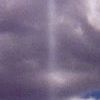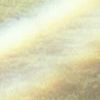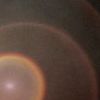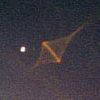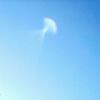When a photo camera is pointed at a bright light source and the shutter button is pressed, there is always a possibility that light entering the camera will cause internal reflections. If this happens, bright spots or complex light patterns may show up in the picture. Cameras with a large number of image-forming elements - for example cameras fitted with a zoom or UV-filter - tend to exhibit lens flares more rapidly, as they contain multiple surfaces at which unwanted internal scattering occurs.
When a bright light source is shining on the lens but is not in its field of view, a lens flare will appear as an area of reduced contrast or as a haze that washes out part of the image. This effect is thought to be responsible for a number of so-called "ghost" or "spirit pictures". When the light is very close to, or on the edge of the field of view, the flare will look more like a beam of light oriented in the direction of the light source that caused the reflection.
When the light source itself is in the field of view of the camera, lens flares can take the shape of an arc with a sunburst pattern, a ring, a three-dimensional looking spindle, an oval blob, or a flat polygonal spot. Often multiple lens flares appear aligned in a row across the image. Their shape and size depend on the curvature of the lenses, the nature of the light source (a setting Sun for example that is partly obscured by the horizon, can produce a secondary image in the shape of a half-disc) and the type of aperture that is used (for example, if the camera has a six-bladed iris shutter, the flare may display a hexagonal pattern).
Lens flares can make very convincing UFOs. Fortunately, they are easy to identify as both the light source and its reflected image are usually located on a line that crosses the centre of the photograph and at equal distances from that centre (how lens flares can be identified is illustrated in some of our case examples).
A somewhat different type of aberration may occur when zooming in on a bright point source. Especially the automatic focus system of early generation camcorders had serious problems with focusing on small lights, transforming stars, planets and distant aircraft lights beyond recognition into big diamond-shaped objects (in the case of a four-bladed iris aperture), or large semi-transparent discs with circle-shaped indentations at the periphery (looking somewhat like biscuits out of which someone has taken one or more bites). The luminous discs are caused by a ring-shaped element inside the zoom lens barrel. The circular indentations by rounded bulges at the inner edge of the ring.
